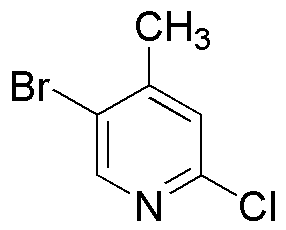5-Bromo-2-chloro-4-methylpyridine is widely utilized in research focused on:
- Pharmaceutical Development: This compound serves as a key intermediate in the synthesis of various pharmaceuticals, particularly in creating antibacterial and antifungal agents, enhancing the efficiency of drug discovery.
- Agricultural Chemistry: It is used in the formulation of agrochemicals, including herbicides and pesticides, contributing to improved crop protection and yield, which is crucial for sustainable agriculture.
- Material Science: The compound is involved in the production of specialized polymers and coatings, offering enhanced durability and resistance to environmental factors, making it valuable in manufacturing industries.
- Research Reagents: As a versatile reagent in organic synthesis, it aids researchers in developing new chemical reactions and pathways, facilitating advancements in chemical research and innovation.
- Analytical Chemistry: It is employed in various analytical techniques, including chromatography, to help identify and quantify other chemical substances, ensuring quality control in manufacturing processes.
General Information
Properties
Safety and Regulations
Applications
5-Bromo-2-chloro-4-methylpyridine is widely utilized in research focused on:
- Pharmaceutical Development: This compound serves as a key intermediate in the synthesis of various pharmaceuticals, particularly in creating antibacterial and antifungal agents, enhancing the efficiency of drug discovery.
- Agricultural Chemistry: It is used in the formulation of agrochemicals, including herbicides and pesticides, contributing to improved crop protection and yield, which is crucial for sustainable agriculture.
- Material Science: The compound is involved in the production of specialized polymers and coatings, offering enhanced durability and resistance to environmental factors, making it valuable in manufacturing industries.
- Research Reagents: As a versatile reagent in organic synthesis, it aids researchers in developing new chemical reactions and pathways, facilitating advancements in chemical research and innovation.
- Analytical Chemistry: It is employed in various analytical techniques, including chromatography, to help identify and quantify other chemical substances, ensuring quality control in manufacturing processes.
Documents
Safety Data Sheets (SDS)
The SDS provides comprehensive safety information on handling, storage, and disposal of the product.
Product Specification (PS)
The PS provides a comprehensive breakdown of the product’s properties, including chemical composition, physical state, purity, and storage requirements. It also details acceptable quality ranges and the product's intended applications.
Certificates of Analysis (COA)
Search for Certificates of Analysis (COA) by entering the products Lot Number. Lot and Batch Numbers can be found on a product’s label following the words ‘Lot’ or ‘Batch’.
*Catalog Number
*Lot Number
Certificates Of Origin (COO)
This COO confirms the country where the product was manufactured, and also details the materials and components used in it and whether it is derived from natural, synthetic, or other specific sources. This certificate may be required for customs, trade, and regulatory compliance.
*Catalog Number
*Lot Number
Safety Data Sheets (SDS)
The SDS provides comprehensive safety information on handling, storage, and disposal of the product.
DownloadProduct Specification (PS)
The PS provides a comprehensive breakdown of the product’s properties, including chemical composition, physical state, purity, and storage requirements. It also details acceptable quality ranges and the product's intended applications.
DownloadCertificates of Analysis (COA)
Search for Certificates of Analysis (COA) by entering the products Lot Number. Lot and Batch Numbers can be found on a product’s label following the words ‘Lot’ or ‘Batch’.
*Catalog Number
*Lot Number
Certificates Of Origin (COO)
This COO confirms the country where the product was manufactured, and also details the materials and components used in it and whether it is derived from natural, synthetic, or other specific sources. This certificate may be required for customs, trade, and regulatory compliance.


